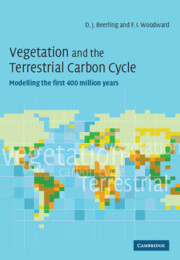Book contents
- Frontmatter
- Contents
- Preface
- Acknowledgements
- 1 Introduction
- 2 Investigating the past from the present
- 3 Climate and terrestrial vegetation
- 4 Climate and terrestrial vegetation of the present
- 5 The late Carboniferous
- 6 The Jurassic
- 7 The Cretaceous
- 8 The Eocene
- 9 The Quaternary
- 10 Climate and terrestrial vegetation in the future
- 11 Endview
- References
- Index
Preface
Published online by Cambridge University Press: 09 August 2009
- Frontmatter
- Contents
- Preface
- Acknowledgements
- 1 Introduction
- 2 Investigating the past from the present
- 3 Climate and terrestrial vegetation
- 4 Climate and terrestrial vegetation of the present
- 5 The late Carboniferous
- 6 The Jurassic
- 7 The Cretaceous
- 8 The Eocene
- 9 The Quaternary
- 10 Climate and terrestrial vegetation in the future
- 11 Endview
- References
- Index
Summary
The study of plant distributions is a continuous feature of ecology. These studies may range from a small area of ground to the whole of the terrestrial biosphere. The information from such studies underpins our current understanding of the terrestrial biosphere. Unfortunately this information, on its own, is not sufficient to answer large questions, such as what controls the current distribution of plants, or how will the current distribution and behaviour of plants respond to global environmental change? These are important questions and ones which are presented increasingly in order to satisfy human knowledge and decision making. Indeed the question, put to ecologists in the 1980s, of how will terrestrial vegetation respond to global warming could not be answered then and only now, 20 years later, is there some hope that we understand some of the major mechanisms involved and their likely outcomes. There is also no doubt that such questions are good for the development of ecology, in contrast to likely serious consequences for mankind.
A feature of long-term studies in ecology is that there is nothing really new, most things have happened before, if only we could have seen them. There is current concern over the rapid increase in atmospheric CO2 concentrations but in geological times the atmospheric CO2 concentrations, and the Earth's temperature have frequently been higher than the present.
- Type
- Chapter
- Information
- Vegetation and the Terrestrial Carbon CycleThe First 400 Million Years, pp. vii - viiiPublisher: Cambridge University PressPrint publication year: 2001

